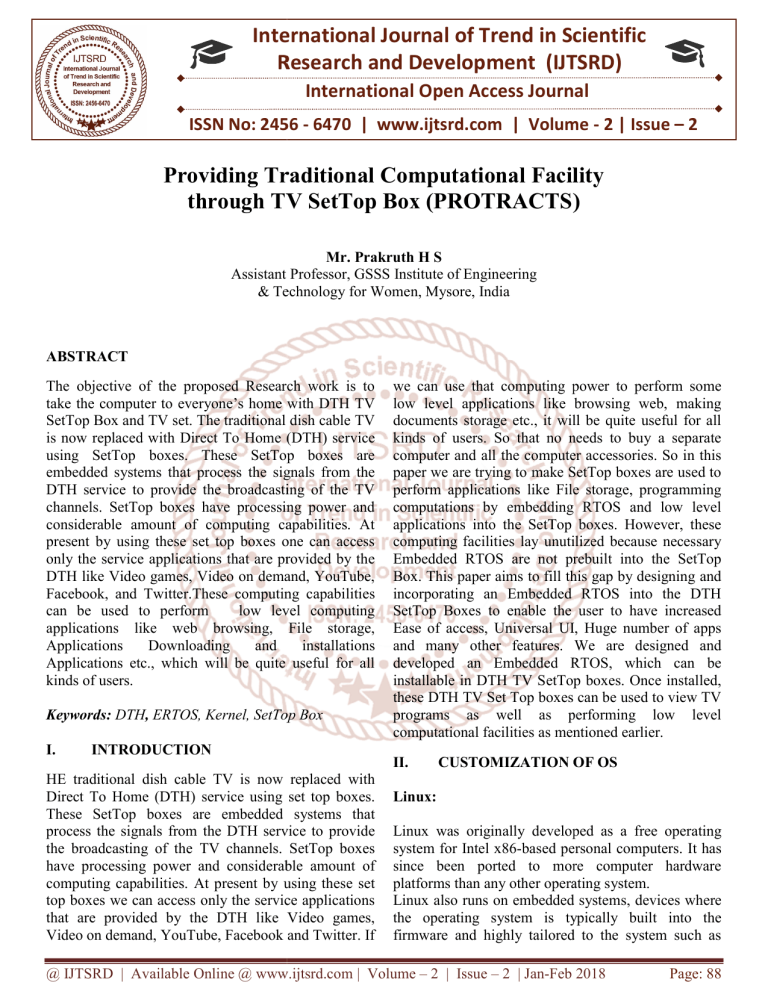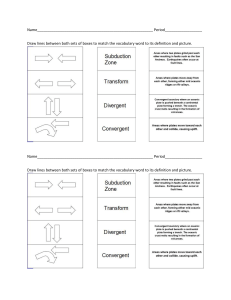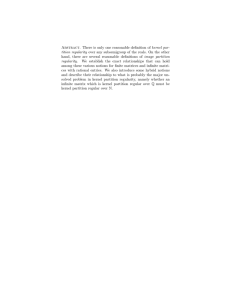
International Journal of Trend in Scientific
Research and Development (IJTSRD)
International Open Access Journal
ISSN No: 2456 - 6470 | www.ijtsrd.com | Volume - 2 | Issue – 2
Providing Traditional Computational Facility
through
hrough TV SetTop Box (PROTRACTS
(PROTRACTS))
Mr. Prakruth H S
Assistant Professor, GSSS Institute of Engineering
& Technology for Women, Mysore, India
ABSTRACT
The objective of the proposed Research work is to
take the computer to everyone’s home with DTH TV
SetTop Box and TV set. The traditional dish cable TV
is now replaced with Direct To Home (DTH) service
using SetTop boxes. These SetTop boxes are
embedded systems
stems that process the signals from the
DTH service to provide the broadcasting of the TV
channels. SetTop boxes have processing power and
considerable amount of computing capabilities. At
present by using these set top boxes one can access
only the servicee applications that are provided by the
DTH like Video games, Video on demand, YouTube,
Facebook, and Twitter.These computing capabilities
can be used to perform
low level computing
applications like web browsing, File storage,
Applications
Downloading
and
nd
installations
Applications etc., which will be quite useful for all
kinds of users.
Keywords: DTH, ERTOS, Kernel, SetTop Box
I.
INTRODUCTION
HE traditional dish cable TV is now replaced with
Direct To Home (DTH) service using set top boxes.
These SetTop boxes are embedded systems that
process the signals from the DTH service to provide
the broadcasting of the TV channels. SetTop boxes
have processing
essing power and considerable amount of
computing capabilities. At present by using these set
top boxes we can access only the service applications
that are provided by the DTH like Video games,
Video on demand, YouTube, Facebook and Twitter. If
we can use that computing power to perform some
low level applications like browsing web, making
documents storage etc., it will be quite useful for all
kinds of users. So that no needs to buy a separate
computer and all the computer accessories. So in this
paper we are trying to make SetTop boxes are used to
perform applications like File storage, programming
computations by embedding RTOS and low level
applications into the SetTop boxes. However, these
computing facilities lay unutilized because necessary
Embedded RTOS are not prebuilt into the SetTop
Box. This paper aims to fill this gap by designing and
incorporating an Embedded RTOS into the DTH
SetTop Boxes to enable the user to have increased
Ease of access, Universal UI, Huge number of apps
and many other features.
ures. We are designed and
developed an Embedded RTOS, which can be
installable in DTH TV SetTop boxes. Once installed,
these DTH TV Set Top boxes can be used to view TV
programs as well as performing low level
computational facilities as mentioned earlier.
II.
CUSTOMIZATION OF OS
Linux:
Linux was originally developed as a free operating
system for Intel x86-based
based personal computers. It has
since been ported to more computer hardware
platforms than any other operating system.
Linux also runs on embedded systems,
system devices where
the operating system is typically built into the
firmware and highly tailored to the system such as
@ IJTSRD | Available Online @ www.ijtsrd.com | Volume – 2 | Issue – 2 | Jan-Feb 2018
Page: 88
International Journal of Trend in Scientific Research and Development (IJTSRD) ISSN: 2456-6470
mobile phones, tablet computers, network routers,
televisions and video game consoles; the Android
system in wide use on mobile devices is built on the
Linux kernel.
A distribution oriented toward desktop use will
typically include the X Window System and an
accompanying desktop environment such as GNOME
or KDE Plasma. Some such distributions may include
a less resource intensive desktop such as LXDE or
Xfce for use on older or less powerful computers. So
we can edit and remove unnecessary files and
applications present in OS, so as to reduce the size
and increase the performance of the system. As it is
free, open source and can be run in different platforms
and different devices as well so we have best choice
of installing Linux in STB with a desktop
environment of choice.
Kernel:
In computing, the kernel is the main component of
most computer operating systems; it is a bridge
between applications and the actual data processing
done at the hardware level. The kernel's
responsibilities include managing thesystem's
resources, the communication between hardware and
software components. Usually, as a basic component
of an operating system, a kernel can provide the
lowest-level abstraction layer for the resources,
especially processors and I/O devices that application
software must control to perform its function. It
typically makes these facilities available to
application
processes
through
inter-process
communication mechanisms and system calls.
The main advantage of Linux kernel is, it is not
originally designed to be portable. Linux is now one
of the most widely ported operating system kernels,
running on a diverse range of systems from the ARM
architecture to the IBM Z/Architecture.
STB contains ARM architecture it is perfect and the
best option to embed Linux.
III.
RELATEDWORK
Kernel Editing:
The kernel is also free and open source. For
customizing OS we should edit the kernel. It can be
edited through the following process:
1. Download the latest version of the Linuxkernel
from http://www.kernel.org.
2. Open the terminal and extract the kernel.
3. Configure the kernel. (make old config,
menuconfig and qconfig/xconfig/gconfig )
4. Once configured, compile and install the kernel.
(make && make modules_install&&make install)
5. So the kernel is installed, now we need to make it
bootable
(mkinitrd
-o
initrd.img<kernelversion><kernelversion>" )
6. Point the boot loader at the new kernel.
IV.
IMPLEMENTATION
Deploying Ubuntu Core:
Procedure:
1. Format target media: at least one partition should
be ext2, ext3, or ext4
2. Unpack Ubuntu Core to ext{2,3,4} partition
3. Install boot-loader
4. Install Linux
5. Add a local user and password for the user, then
add the user to the adm and sudo groups.
6. If the Linux kernel requires modules, add these to
/lib/modules/$(uname -r) in the ext{2,3,4} file
system .
7. Boot the target device.
8. Install any additional required software using aptget.
Script to partition/format SDCards
*$ sudo ./omap3-mkcard.sh /dev/sd<x>
* #!/bin/bash
if [ ! "$1" = "/dev/sda" ] ; then
unset LANG
DRIVE=$1
if [ -b "$DRIVE" ] ; then
dd if=/dev/zero of=$DRIVE bs=1024
count=1024
SIZE=`fdisk -l $DRIVE | grep Disk |
awk '{print $5}'`
echo DISK SIZE - $SIZE bytes
CYLINDERS=`echo
$SIZE/255/63/512 | bc`
echo CYLINDERS - $CYLINDERS
{
echo ,9,0x0C,*
echo ,,,} | sfdisk -D -H 255 -S 63 -C
$CYLINDERS $DRIVE
mkfs.vfat -F 32 -n "boot" ${DRIVE}1
mke2fs -j -L "rootfs" ${DRIVE}2
@ IJTSRD | Available Online @ www.ijtsrd.com | Volume – 2 | Issue – 2 | Jan-Feb 2018
Page: 89
International Journal of Trend in Scientific Research and Development (IJTSRD) ISSN: 2456-6470
fi
17.
fi
18.
Step by Step Instructions to format SD card
Since putting a Linux file system on a FAT32
partition is problematic, it is recommended to also
create a 2nd partition.
Insert your SD card into your Linux box
Do not mount it
The card shows up as /dev/sd*. To identify the card,
you can either do:
dmesg | grepsd[a-z]. You will see something like
[172407.246308] sdb: sdb1 sdb2 so drive is /dev/sdb
ls /dev/sd* before and after plugging SD card and
find created devices
Delete existing Partitions:
Command (m for help): d
Partition number (1-4): 1
Command (m for help): d
Partition number (1-4): 2
Configure SD Card:
Command (m for help): x
Expert command (m for help): h
Number of heads (1-256, default 30): 255
Expert command (m for help): s
Number of sectors (1-63, default 29): 63
Warning: setting sector offset for DOS compatibility
Expert command (m for help): c
Number of cylinders (1-1048576, default 2286):
<new_cylinders calculated from above>
Configure SD Partitions:
1. Expert command (m for help): r
2. Command (m for help): n
3. Command action
4. e extended
5. p primary partition (1-4)p
6. Partition number (1-4): 1
7. First cylinder (1-123, default 1):
8. Using default value 1
9. Last cylinder or +size or +sizeM or +sizeK (1123, default 123): +64M
10. Command (m for help): n
11. Command action
12. e extended
13. p primary partition (1-4)p
14. Partition number (1-4): 2
15. First cylinder (10-123, default 10):
16. Using default value 10
Last cylinder or +size or +sizeM or +sizeK (10123, default 123):
Using default value 123
Check Partition Table.
Command (m for help):
Disk /dev/sdc: 993 MB, 993001472 bytes
255 heads, 63 sectors/track, 120 cylinders
Units = cylinders of 16065 * 512 = 8225280 bytes
Disk identifier: 0x00000000
Device Boot Start End Blocks Id System:
/dev/sdc1 * 1 9 72261 c W95 FAT32 (LBA)
/dev/sdc2 10 120 891607+ 83 Linux
Command (m for help): w
The partition table has been altered!
Calling ioctl() to re-read partition table.
Creating a mount point:
mkdir /tmp/mmc1
mkdir /tmp/mmc2
sudo mount /dev/sdc1 /tmp/mmc1
sudo mount /dev/sdc2 /tmp/mmc2.
ODROID-X:
ODROID-X is a micro sized open development
platform which is powered by Exynos4412. 1.4Ghz
ARM Cortex-A9 Quad Cores show PC-like
performance with compatible architecture of android
mobiles, STB’s .
Configuration:
ARM processor Cortex-A9 1.4GHz
Mali-400 MP Core
6 x High Speed USB2.0 Host Port
10/100Mbps Ethernet with RJ-45 LAN Jack
USES:
The OMAP boards have better configuration but
with low compatibility with TV.
Beagle board is compatible with TV but has low
configuration.
ODROID-X is compatible and has good
configuration. So, now the best choice among the
boards is ODROID-X board.
V.
CONCLUSION
we can use the computing power of STB to perform
some low level applications like browsing web,
@ IJTSRD | Available Online @ www.ijtsrd.com | Volume – 2 | Issue – 2 | Jan-Feb 2018
Page: 90
International Journal of Trend in Scientific Research and Development (IJTSRD) ISSN: 2456-6470
making documents storage etc., it will be quite useful
for all kinds of users. So that no needs to buy a
separate computer. So in this research work we are
trying to make set top boxes are used to perform
applications like File storage, programming
computations by embedding RTOS and low level
applications into the set top boxes.
REFERENCES
1. Lalit Kumar, Rajesh Kushwaha, Rishi Prakash:
"Design & Development of small Linux Operating
System for Brower Based Digital set Top Box",
2009 First International Conference on
Computational
Intelligence,
Communication
Systems and Networks, pp. 277-281
2. Implementation of internet browsing on Set Top
Box using ARM-LinuxNirmala, L; Manvi, Sunil
Kumar
S.; Reddy,
R.Sreenivasa
IET
CONFERENCE PUBLICATIONS
@ IJTSRD | Available Online @ www.ijtsrd.com | Volume – 2 | Issue – 2 | Jan-Feb 2018
Page: 91




